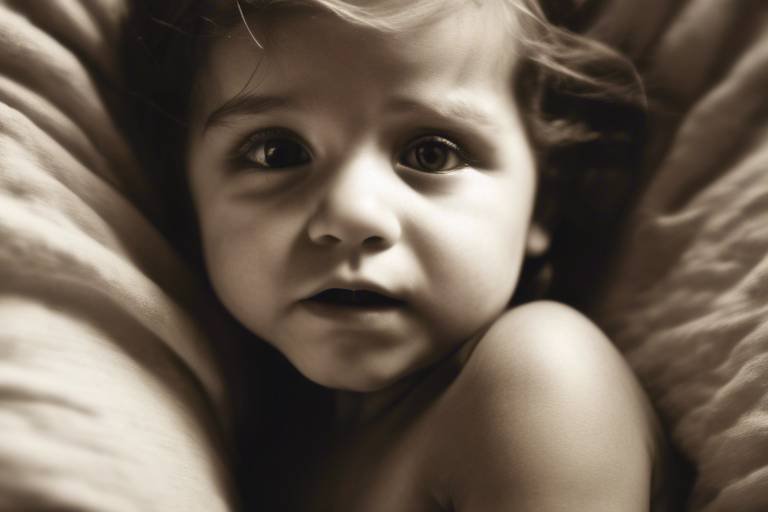Recovering From Childhood Trauma: A Step-by-Step Guide
Recovering from childhood trauma is a journey that requires courage, patience, and a deep understanding of oneself. It's not just about moving past the pain; it's about learning to embrace life with renewed hope and resilience. Imagine standing at the edge of a vast ocean, waves crashing against the shore, representing the tumultuous emotions and memories that often feel overwhelming. But, just like the ocean, there are calm waters waiting for you, where peace and healing can be found. This guide is designed to help you navigate your unique path to recovery, offering practical steps and insights that can illuminate your way forward.
Childhood trauma can take many forms, and its impact can resonate throughout a person's life. It encompasses a wide range of experiences, including emotional abuse, physical abuse, sexual abuse, and even neglect. These experiences can leave deep emotional scars, shaping how individuals perceive themselves and interact with the world around them. Think of childhood trauma as a shadow that follows you, influencing your thoughts, feelings, and behaviors without you even realizing it. It's crucial to understand these roots to begin the healing process effectively.
The psychological effects of childhood trauma can be profound and far-reaching. Many individuals struggle with conditions such as anxiety, depression, and even post-traumatic stress disorder (PTSD). These aren't just buzzwords; they represent real challenges that can affect daily functioning and overall well-being. Recognizing these symptoms is the first step toward effective recovery. It’s like identifying the warning signs on a road trip; if you know where the potholes are, you can navigate around them more easily.
Understanding the common symptoms of trauma can help individuals identify their own struggles or those of loved ones. Here are some typical signs that may indicate someone is grappling with the aftermath of childhood trauma:
Emotional responses to trauma can manifest in various ways. You might experience mood swings, feel an overwhelming sense of anger, or struggle with feelings of worthlessness. These emotional states can significantly impact daily life and relationships, creating a cycle of distress that feels impossible to break. It’s like trying to navigate a stormy sea without a compass. Understanding these feelings is essential for finding your way back to calmer waters.
Trauma doesn’t just affect the mind; it can also manifest physically. Many individuals report experiencing chronic pain, fatigue, and sleep disturbances. This connection between mind and body underscores the importance of holistic healing approaches. The body often holds onto trauma just as much as the mind, making it essential to address both aspects during recovery.
As you embark on this healing journey, having practical coping strategies at your disposal can be incredibly beneficial. Here are a few techniques to consider:
- Mindfulness Meditation: Practicing mindfulness can help ground you in the present moment, reducing anxiety and promoting emotional regulation.
- Journaling: Writing down your thoughts and feelings can provide an outlet for expression, allowing you to process your experiences more effectively.
- Physical Activity: Engaging in regular exercise can boost your mood and improve your overall sense of well-being.
These strategies can serve as stepping stones, guiding you toward a more resilient and fulfilling life. Remember, recovery is not linear; there will be ups and downs, but each step forward is a victory worth celebrating.
While self-help strategies are valuable, seeking professional support is often a crucial component of recovery. Therapists trained in cognitive-behavioral therapy and trauma-informed care can provide specialized guidance tailored to your needs. They can help you unpack your experiences and develop coping mechanisms that resonate with you.
Choosing a qualified therapist can feel daunting, but it’s essential for building a supportive therapeutic relationship. Consider factors such as their specialization, approach, and your personal comfort level with them. It’s like finding the right pair of shoes; they should fit well and support your journey.
Building a support network is vital for recovery. Surrounding yourself with friends, family, and support groups can create a safety net that encourages healing. Community resources, such as local mental health organizations, can also provide additional support and guidance. Remember, you don’t have to walk this path alone; there are people and resources ready to help you along the way.
1. What is childhood trauma?
Childhood trauma refers to distressing experiences that occur during childhood, including abuse, neglect, or witnessing violence. These experiences can significantly impact emotional and psychological development.
2. How can I tell if I have unresolved trauma?
Common signs include persistent feelings of sadness, anxiety, mood swings, difficulty in relationships, or physical symptoms like chronic pain. If you resonate with these, consider reaching out for help.
3. Is it possible to recover from childhood trauma?
Yes, recovery is possible! With the right support, coping strategies, and professional help, individuals can heal and lead fulfilling lives.
4. How long does the healing process take?
The healing process is unique to each individual. It can take time, and it's important to be patient with yourself as you navigate your journey.

Understanding Childhood Trauma
Childhood trauma is a complex and multifaceted issue that can have profound and lasting effects on an individual's mental and emotional health. It encompasses a wide range of experiences that can deeply impact a child's development and sense of self. Trauma can manifest in various forms, including emotional, physical, and sexual abuse, as well as neglect. Each of these experiences can leave a mark, shaping not only how children perceive the world around them but also how they relate to others as they grow into adulthood.
To better understand childhood trauma, it's essential to recognize the different types that can occur:
- Emotional Abuse: This includes behaviors that harm a child's self-esteem, such as constant criticism, rejection, or humiliation.
- Physical Abuse: This involves any intentional physical harm, including hitting, kicking, or other forms of violence against a child.
- Sexual Abuse: This is any sexual activity with a child, which can lead to severe emotional and psychological consequences.
- Neglect: This occurs when a child's basic needs—such as food, shelter, and emotional support—are not met.
Each type of trauma can lead to a cascade of emotional responses and coping mechanisms that can affect individuals throughout their lives. For instance, a child who experiences neglect may struggle with feelings of unworthiness and abandonment, while one who suffers from emotional abuse may develop a distorted self-image and issues with trust. Understanding these underlying issues is crucial for healing, as it helps individuals recognize the roots of their behaviors and emotional struggles.
Moreover, the impact of childhood trauma isn't just limited to the emotional realm; it can also have physical repercussions. Children who endure traumatic experiences often develop stress-related conditions, which can manifest as chronic pain, fatigue, or other health problems. This highlights the critical connection between mental and physical health, underscoring the need for a holistic approach to recovery.
In summary, understanding childhood trauma is the first step toward healing. By recognizing the various forms it can take and acknowledging the profound effects it can have on mental and physical health, individuals can begin to navigate their journey toward recovery. The journey may not be easy, but with the right support and resources, it is entirely possible to reclaim a sense of peace and well-being.

The Impact of Trauma on Mental Health
When we talk about the impact of childhood trauma on mental health, we're diving into a complex web of emotions and experiences that can shape an individual for a lifetime. It’s like a pebble thrown into a pond; the ripples extend far beyond the initial splash. Trauma can manifest in various psychological symptoms, often leading to conditions such as anxiety, depression, and post-traumatic stress disorder (PTSD). These aren’t just buzzwords; they represent real challenges that can hinder daily functioning and overall quality of life.
Imagine walking through life with a heavy backpack filled with stones, each representing a traumatic experience. The weight can become unbearable, leading to feelings of hopelessness and despair. It’s crucial to recognize these symptoms early on, as they can be the first step towards healing. Understanding the psychological effects of trauma is essential, not just for those who have experienced it, but also for their loved ones who may be trying to support them.
Common psychological symptoms of childhood trauma can include:
- Anxiety: This can manifest as constant worry, panic attacks, or a general sense of dread.
- Depression: Individuals may feel persistently sad or lose interest in activities they once enjoyed.
- PTSD: Flashbacks, nightmares, and severe emotional distress triggered by reminders of the trauma are typical symptoms.
These symptoms can create a vicious cycle, where the individual feels trapped in their own mind. It’s essential to break this cycle through recognition and intervention. Understanding that these responses are valid and that they stem from past experiences can be liberating. It’s like finally finding the key to a locked door that has kept you confined for too long.
Moreover, the impact of trauma doesn’t just stay in the mind; it often spills over into physical health. Many individuals may experience chronic pain, fatigue, or sleep disturbances, which further complicates the healing process. The connection between the mind and body is profound, and addressing one often requires attention to the other. It’s a reminder that healing is holistic—it involves nurturing both mental and physical well-being.
In summary, the impact of childhood trauma on mental health is significant and multifaceted. Recognizing the symptoms and understanding their origins is the first step towards healing. It’s important to approach recovery with compassion, both for oneself and for others who may be struggling. Remember, you’re not alone in this journey, and there are paths to recovery that can lead to a brighter future.
- What are the signs of childhood trauma? Common signs include anxiety, depression, mood swings, and physical symptoms like chronic pain.
- Can childhood trauma affect adult relationships? Yes, unresolved trauma can lead to trust issues, fear of intimacy, and difficulty in forming healthy relationships.
- How can I start healing from childhood trauma? Seeking professional help, practicing self-care, and building a support network are essential steps in the healing process.

Common Symptoms of Trauma
When we talk about childhood trauma, it's essential to recognize that its effects can be both profound and subtle. Many individuals may not fully understand the signs that indicate they are grappling with the aftermath of their past experiences. Trauma doesn't wear a neon sign; instead, it often hides beneath the surface, manifesting in various ways that can disrupt daily life. So, what should you look out for? Here are some common symptoms that may suggest someone is struggling with trauma:
- Emotional Symptoms: These can include intense mood swings, feelings of anger, and a pervasive sense of worthlessness. Imagine trying to navigate a ship through a storm; one moment you're calm, and the next, waves of emotion crash over you, leaving you feeling lost and overwhelmed.
- Physical Symptoms: Trauma can also take a toll on the body, leading to chronic pain, fatigue, and sleep disturbances. It's as if your body is echoing the turmoil of your mind, creating a cycle that can be difficult to break.
- Cognitive Symptoms: Many individuals experience difficulties with concentration, memory issues, or even intrusive thoughts. It's like trying to watch a movie, but the screen keeps flickering, making it hard to grasp the storyline.
- Behavioral Symptoms: You might notice changes in behavior, such as withdrawal from social activities or an increase in risky behaviors. This can be a form of self-protection, akin to a turtle retreating into its shell when faced with danger.
Understanding these symptoms is crucial for both individuals and their loved ones. Recognizing the signs can pave the way for seeking help and embarking on a healing journey. Remember, acknowledging that something isn't quite right is the first step toward recovery. If you or someone you know resonates with these symptoms, it's vital to approach the situation with compassion and understanding.
In conclusion, trauma can leave a lasting imprint on one's mental and physical health. The journey to healing is often complex, but by identifying these common symptoms, individuals can take proactive steps toward recovery. Whether it’s through self-reflection, seeking support, or professional help, every small step counts in reclaiming your life from the shadows of trauma.
Q: What is childhood trauma?
A: Childhood trauma refers to distressing experiences that occur during childhood, which can include emotional, physical, or sexual abuse, neglect, or witnessing violence. These experiences can significantly impact a child's development and mental health.
Q: How can I tell if I am experiencing trauma symptoms?
A: Symptoms of trauma can vary widely but often include emotional instability, physical health issues, cognitive difficulties, and behavioral changes. If you notice persistent distress in these areas, it may be beneficial to seek professional guidance.
Q: Is it possible to heal from childhood trauma?
A: Yes, healing from childhood trauma is possible. Many individuals find relief and recovery through therapy, support groups, and personal coping strategies. The journey may be challenging, but with the right support, it can lead to profound transformation.

Emotional Symptoms
When we talk about stemming from childhood trauma, it's like peeling back the layers of an onion—each layer revealing deeper pain and unresolved feelings. Individuals who have experienced trauma often find themselves grappling with intense emotions that can feel overwhelming and confusing. For instance, mood swings can occur unexpectedly, leaving one feeling like they’re on a roller coaster of emotions. One moment you might be on top of the world, and the next, a wave of sadness crashes down, leaving you questioning what just happened.
Another common emotional response is anger. This isn’t just a fleeting irritation; it can manifest as a deep-seated rage that feels uncontrollable. It’s essential to understand that this anger often masks deeper feelings of hurt and betrayal. Imagine trying to build a sandcastle only to have the tide wash it away—this frustration can lead to outbursts that affect not only the individual but also their relationships with family and friends.
Feelings of worthlessness are also prevalent among those recovering from childhood trauma. These individuals might struggle with self-esteem, constantly questioning their value and place in the world. It’s as if they carry a heavy backpack filled with stones labeled “not enough” or “unlovable,” making every step they take feel like an uphill battle. This sentiment can permeate various aspects of life, including career choices and personal relationships, leading to a cycle of self-doubt.
Moreover, many individuals might experience a sense of emotional numbness. It’s as if they’ve built an emotional wall to protect themselves from further pain, but in doing so, they also block out joy and happiness. This numbness can make it challenging to connect with others, leading to feelings of isolation and loneliness. Imagine sitting at a party surrounded by laughter, yet feeling like you’re watching from behind a glass wall—this disconnect can be particularly painful.
Recognizing these emotional symptoms is the first step toward healing. It's crucial to acknowledge that these feelings are valid and that you are not alone in this journey. Seeking support, whether through therapy or support groups, can help individuals navigate these complex emotional landscapes. The road to recovery may be long, but with the right tools and support, it is possible to break free from the chains of childhood trauma and reclaim a sense of joy and fulfillment in life.
In summary, the emotional symptoms of childhood trauma are varied and complex. By understanding these symptoms and seeking help, individuals can begin to heal and rebuild their lives. Remember, healing is not a linear process; it’s a journey filled with ups and downs, but every step forward is a victory worth celebrating.
- What are some signs of emotional trauma? Emotional trauma can manifest through mood swings, anger, feelings of worthlessness, and emotional numbness.
- How can I cope with these emotional symptoms? Coping strategies include seeking therapy, practicing mindfulness, and engaging in supportive communities.
- Is it normal to feel angry after experiencing trauma? Yes, anger is a common response to trauma, often masking deeper feelings of pain and betrayal.
- How long does it take to heal from childhood trauma? Healing is a personal journey and can vary greatly from individual to individual.

Physical Symptoms
When we think about childhood trauma, we often focus on the emotional and psychological scars it leaves behind. However, the of trauma are equally significant and can manifest in various ways. It's fascinating—and somewhat alarming—to realize that our bodies can carry the weight of our experiences, often expressing what we cannot put into words. For many individuals, trauma can lead to chronic pain, fatigue, and sleep disturbances, creating a vicious cycle that exacerbates mental health issues.
Chronic pain is a common physical symptom that can stem from unresolved trauma. This pain can be elusive, often shifting locations and intensities, making it difficult for individuals to pinpoint its origin. It's almost as if the body is trying to communicate the turmoil trapped within. For instance, someone who experienced emotional neglect might find themselves with unexplained back pain, as their body holds onto the tension and stress of their unresolved feelings.
Fatigue is another prevalent symptom that many individuals struggle with. Imagine waking up after a full night's sleep, yet feeling as though you could sleep for another week. This pervasive tiredness can be a direct result of the body's constant state of alertness, a remnant of the fight-or-flight response that trauma can trigger. The brain, constantly on guard, can drain the body’s energy reserves, leaving individuals feeling physically and emotionally exhausted.
Sleep disturbances, including insomnia or nightmares, often plague those recovering from childhood trauma. The mind may replay traumatic events during sleep, leading to restless nights and heightened anxiety. This lack of restorative sleep can further impair mental health, creating a cycle that feels impossible to break. It’s crucial to understand that these physical symptoms are not merely byproducts of trauma; they are integral to the healing process.
To illustrate this connection between trauma and physical symptoms, consider the following table:
| Physical Symptom | Possible Cause |
|---|---|
| Chronic Pain | Body's response to emotional stress and unresolved trauma |
| Fatigue | Constant state of alertness depleting energy levels |
| Sleep Disturbances | Nightmares or insomnia stemming from trauma-related anxiety |
Recognizing these physical symptoms is the first step toward healing. If you or someone you know is experiencing these issues, it’s essential to address both the physical and emotional aspects of recovery. Engaging in practices such as mindfulness, yoga, or even gentle exercise can help reconnect the body and mind, promoting healing from the inside out. Remember, healing is not just about addressing the emotional pain; it’s also about listening to your body and giving it the care it deserves.
- What are some common physical symptoms of childhood trauma? Common symptoms include chronic pain, fatigue, and sleep disturbances.
- How can I manage physical symptoms related to trauma? Engaging in mindfulness practices, exercise, and seeking professional help can aid in managing these symptoms.
- Is it necessary to address physical symptoms separately from emotional ones? Yes, both aspects are interconnected, and addressing them together can enhance the healing process.

Coping Strategies for Healing
Healing from childhood trauma is like embarking on a journey through a dense forest—it's often dark, winding, and filled with unexpected obstacles. However, with the right tools and strategies, you can find your way out and emerge stronger than before. One of the most effective coping strategies is the practice of mindfulness. This involves being present in the moment and acknowledging your thoughts and feelings without judgment. Mindfulness can help you create a space where you can observe your emotions rather than becoming overwhelmed by them.
Another powerful strategy is journaling. Writing down your thoughts and feelings can be incredibly cathartic. It’s like having a conversation with yourself, allowing you to process your experiences and emotions. You might want to consider setting aside a few minutes each day to jot down your thoughts. This simple act can lead to profound insights and help you track your progress over time. Additionally, engaging in creative outlets such as art, music, or dance can provide a means of expression that words sometimes fail to capture.
Physical activity is also crucial in the healing process. Exercise releases endorphins, which are natural mood lifters. Whether it’s a brisk walk in the park or an intense workout at the gym, moving your body can help alleviate some of the emotional weight you carry. If you're not sure where to start, consider activities that you enjoy, such as yoga or swimming, which also promote relaxation and mindfulness.
Building a strong support network is essential. Surrounding yourself with understanding and empathetic individuals can make a world of difference. This could be close friends, family members, or even support groups where you can share your experiences with others who have faced similar challenges. Remember, you’re not alone on this journey, and sharing your story can be incredibly liberating.
Lastly, don't underestimate the power of self-compassion. Treat yourself with the same kindness and understanding that you would offer a friend. This means acknowledging that healing takes time and that it’s okay to have setbacks along the way. By embracing self-compassion, you can foster a more positive relationship with yourself, which is crucial for long-term recovery.
In summary, the journey of healing from childhood trauma is multifaceted and highly personal. By incorporating mindfulness, journaling, physical activity, building a support network, and practicing self-compassion into your daily life, you can create a robust framework for recovery. Remember, every step you take, no matter how small, is a step towards healing.
- What is childhood trauma? Childhood trauma refers to distressing experiences during childhood, including abuse, neglect, or witnessing violence, which can have lasting effects on mental and emotional health.
- How can I identify if I am experiencing symptoms of trauma? Symptoms can vary but may include anxiety, depression, mood swings, and physical manifestations like chronic pain. If you recognize these signs, it may be helpful to seek professional support.
- Is it necessary to seek professional help for healing? While self-help strategies can be beneficial, professional guidance can provide tailored support and therapeutic techniques that facilitate deeper healing.
- How long does the healing process take? Healing is a personal journey that varies for everyone. It’s important to be patient with yourself and recognize that progress may come in waves.

Seeking Professional Help
When it comes to healing from childhood trauma, seeking professional help is not just a suggestion; it's a crucial step in the recovery process. Imagine trying to navigate a dense forest without a map or a guide. That's often what healing feels like for many individuals. Professionals, such as therapists and counselors, can provide the guidance needed to navigate those tangled paths of emotions and memories. They offer a safe space to explore feelings that may have been buried for years, allowing for a deeper understanding of oneself.
There are various therapeutic approaches available, and it's essential to find one that resonates with you. For example, cognitive-behavioral therapy (CBT) focuses on identifying and changing negative thought patterns, while trauma-informed care emphasizes understanding the impact of trauma on an individual’s life and tailoring treatment accordingly. Each approach has its strengths, and what works for one person may not work for another. Therefore, it’s vital to explore different options to find the right fit for your healing journey.
But how do you know when it's time to seek help? If you find yourself feeling overwhelmed by emotions, struggling to maintain relationships, or experiencing symptoms like anxiety or depression, these may be signs that professional support could be beneficial. It's like having a toolbox: sometimes, you need a specialized tool to fix a specific problem. Professionals can provide those tools and teach you how to use them effectively.
When searching for the right therapist, consider factors such as their specialization, approach, and your own comfort level with them. You might want to ask questions like:
- What is your experience with childhood trauma?
- What therapeutic approaches do you use?
- How do you ensure a safe and supportive environment?
Finding a therapist who understands your unique experiences can make all the difference. It's not just about qualifications; it's about finding someone who you feel comfortable opening up to. Think of it as dating: you’re looking for a connection that feels right.
Additionally, don't underestimate the power of support networks. Friends, family, and support groups can play a significant role in your healing process. They provide a sense of community and understanding, reminding you that you are not alone in your journey. Just like a team working together, having a support system can help you stay motivated and accountable as you work through your feelings and experiences.
In conclusion, seeking professional help is a vital step in recovering from childhood trauma. It opens the door to understanding, healing, and resilience. Remember, it’s okay to ask for help; it’s a sign of strength, not weakness. Embrace the journey, and take the first step toward a healthier, happier you.
1. How do I know if I need therapy?
If you're experiencing overwhelming emotions, difficulty in relationships, or symptoms of anxiety or depression, it may be time to seek professional help.
2. What should I look for in a therapist?
Look for their specialization in childhood trauma, their therapeutic approach, and whether you feel comfortable with them.
3. Are there different types of therapy for trauma?
Yes, there are various types, including cognitive-behavioral therapy, trauma-informed care, and EMDR, each with its unique focus and techniques.
4. How can support networks help me?
Support networks provide emotional support, understanding, and encouragement, reminding you that you are not alone in your healing journey.

Finding the Right Therapist
Finding the right therapist can feel like searching for a needle in a haystack, especially when you're already dealing with the weight of childhood trauma. It's crucial to remember that therapy is a deeply personal journey, and what works for one person may not work for another. So, how do you navigate this often-overwhelming process? First and foremost, consider your specific needs and preferences. Are you looking for someone who specializes in trauma recovery? Or perhaps you want a therapist who employs a particular approach, like cognitive-behavioral therapy (CBT) or mindfulness-based techniques. Understanding your preferences can significantly narrow down your options.
Next, think about the importance of compatibility. Just like you wouldn’t want to wear shoes that don’t fit, you shouldn’t settle for a therapist who doesn’t resonate with you. It’s okay to meet with several therapists before making a decision. When you do meet a potential therapist, pay attention to how you feel during the session. Do you feel heard and understood? Is the environment comfortable? These factors can greatly influence your healing process.
Another essential aspect is to check the therapist’s credentials and experience. Make sure they are licensed and have experience working with trauma survivors. You might consider asking questions like:
- What is your approach to therapy?
- How many clients have you worked with who have experienced similar trauma?
- What can I expect from our sessions?
Don’t hesitate to express your concerns or ask about their strategies for helping clients heal. After all, this is about your well-being. Additionally, consider logistical aspects such as location, availability, and cost. Many therapists offer sliding scale fees or accept insurance, which can ease the financial burden.
Finally, trust your instincts. If something feels off, it’s perfectly okay to seek someone else. Remember, this journey is about you, and finding the right therapist can be a pivotal step toward healing. The right fit can help you feel safe, understood, and empowered to face your past and build a brighter future.
Q: How do I know if I need therapy?
A: If you are experiencing overwhelming emotions, difficulty in daily life, or unresolved issues from your past, therapy can be a beneficial option to explore.
Q: What should I expect in my first therapy session?
A: The first session typically involves discussing your background, current challenges, and what you hope to achieve in therapy. It's a chance to get to know your therapist and see if it's a good fit.
Q: How long does therapy usually last?
A: The duration of therapy varies widely depending on individual needs and goals. Some may find relief in just a few sessions, while others may benefit from longer-term support.
Q: Can therapy really help with childhood trauma?
A: Yes! Therapy can provide a safe space to process past experiences, develop coping strategies, and foster resilience, ultimately leading to healing and personal growth.

Support Networks and Community Resources
Recovering from childhood trauma can feel like navigating a maze without a map. It’s a journey often filled with twists, turns, and unexpected obstacles. However, one of the most vital components of this journey is the support network you build around yourself. Having a solid support system can make a world of difference. Think of it as having a safety net; it catches you when you stumble and offers encouragement when you feel like giving up.
Support networks can come in many forms. Friends and family who understand your struggles can provide emotional support, while support groups offer a space to share experiences with others who have walked similar paths. These groups can be invaluable, as they foster a sense of community and belonging. You may find that speaking with someone who truly understands can be a healing experience in itself.
Additionally, community resources play a crucial role in recovery. Local organizations often provide workshops, counseling services, and even recreational activities that can help individuals reconnect with themselves and others. Here’s a breakdown of some types of community resources you might explore:
- Counseling Centers: Many cities have mental health clinics that offer affordable or sliding-scale therapy.
- Support Groups: Look for groups specifically focused on trauma recovery, which can often be found through local mental health organizations.
- Hotlines: If you're in immediate need of support, hotlines can provide confidential assistance and guidance.
- Workshops and Retreats: These can offer therapeutic activities like art therapy, yoga, or mindfulness, which are beneficial for healing.
Finding the right support network is not just about gathering people around you; it’s about creating a safe space where you can express yourself freely. It’s essential to surround yourself with individuals who respect your journey and offer encouragement without judgment. Remember, it’s perfectly okay to seek out new connections if your current relationships don’t provide the support you need.
In addition to personal connections, consider utilizing online resources. There are numerous forums and social media groups dedicated to trauma recovery where you can share your story and gain insights from others. These platforms can be particularly helpful for those who may feel isolated or are unable to attend in-person meetings.
Ultimately, your recovery is a personal journey, and while it may feel daunting at times, remember that you are not alone. With the right support network and community resources, you can find the strength to heal and thrive. So, take that first step—reach out, connect, and allow yourself to be supported on this transformative journey.
Q: What is a support network, and why is it important for trauma recovery?
A: A support network is a group of people who provide emotional, social, and practical support. It is crucial for trauma recovery because it offers understanding, encouragement, and shared experiences, which can significantly aid the healing process.
Q: How can I find local support groups for childhood trauma?
A: You can search online for local mental health organizations, community centers, or hospitals that offer support groups. Websites like Meetup or Facebook groups can also help you connect with local support networks.
Q: Are online support groups effective?
A: Yes! Online support groups can be very effective, especially for those who may feel isolated or have mobility issues. They provide a platform for sharing experiences and gaining support from others who understand your journey.
Frequently Asked Questions
- What is childhood trauma?
Childhood trauma refers to distressing experiences that occur during childhood, such as emotional, physical, or sexual abuse, as well as neglect. These experiences can significantly impact a child's emotional and psychological development, leading to long-term effects on mental health.
- How does childhood trauma affect mental health?
Childhood trauma can lead to various mental health issues, including anxiety, depression, and post-traumatic stress disorder (PTSD). Individuals may struggle with emotional regulation, experience mood swings, or develop negative self-perceptions as a result of their traumatic experiences.
- What are common symptoms of trauma?
Common symptoms of trauma include emotional responses like anger, sadness, and feelings of worthlessness. Physical symptoms may manifest as chronic pain, fatigue, or sleep disturbances. Recognizing these symptoms is crucial for seeking appropriate help and support.
- What coping strategies can help in healing from trauma?
Effective coping strategies include mindfulness practices, journaling, and engaging in physical activities. Building a routine, seeking social support, and exploring creative outlets can also foster resilience and emotional well-being during the healing process.
- When should I seek professional help for trauma?
If you find that your symptoms are interfering with daily life, relationships, or overall well-being, it may be time to seek professional help. A therapist can provide tailored support and therapeutic approaches to facilitate your healing journey.
- How do I find the right therapist for trauma recovery?
Finding the right therapist involves researching their qualifications, specialties, and therapeutic approaches. It's important to consider compatibility and comfort level, as a supportive therapeutic relationship is vital for effective healing.
- What role do support networks play in recovery?
Support networks, including friends, family, and support groups, are essential in the recovery process. They provide emotional support, understanding, and encouragement, helping individuals feel less isolated in their healing journey.
- Are there community resources available for trauma recovery?
Yes, many communities offer resources such as support groups, counseling services, and workshops focused on trauma recovery. These resources can provide valuable support and connection for individuals navigating their healing journey.



















